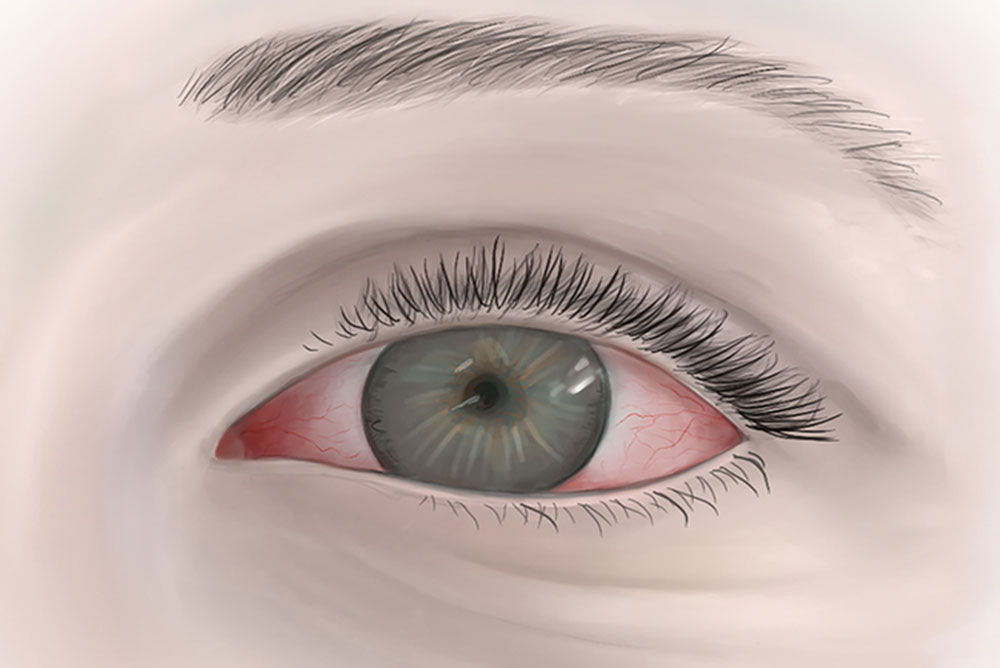
iStock
AFTER FEELING a sharp pain, Prague-based journalist C.M. saw that one of her eyes appeared full of bright red blood. C.M. wondered about blood pressure—although hers is moderate to low—or coughing as possible causes. Only for a medical emergency would she be willing to leave her apartment mid-pandemic for crowded streets and few people wearing masks.
Not just red, but also pink, yellow and orange are possible colors that can appear when tiny blood vessels in the eye swell, leak or burst to cause a subconjunctival hemorrhage, which may look alarming but is usually nothing to worry about.
Coughing, along with sneezing, vomiting or just bending over are common causes—as is strenuous exercise or weight-training, especially if holding the breath or not breathing continuously. In the morning-after bloodshot eye, alcohol dilates the tiny blood vessels: the more alcohol, the more visible and red these vessels can appear against the whites of the eyes.
The bloody or bloodshot eye is like a bruise—in this case, with blood trapped under the conjunctiva, the thin membrane on the eye’s surface. The best treatment is time, as long as three weeks, for the eye to absorb trapped blood and slowly turn white again.
What might require a complete physical exam is more than one hemorrhage or if blood appears inside the iris; also if hemorrhages recur—some experts say in the span of a few months, but others say more than two of these in a year. Frequent hemorrhages can be warning signs of hypertension, diabetes or disorders of the blood, including leukemia.
If itching “like crazy” accompanies eye redness, the diagnosis may be pinkeye, or conjunctivitis, which can be the result of allergies or something small in the eye like a stray eyelash. But if the cause is bacteria or a virus, pinkeye requires frequent hand-washing to prevent spreading—and a doctor’s visit for diagnosis and sometimes antibiotic treatment.
Lack of sleep can cause eye redness, because keeping the eyes opened for too long dries out the cornea. But if the cause is sleep apnea—for which eye redness can be a sign—that may indicate increased risk of glaucoma.
Seeing an eye doctor might be important when eye symptoms accompanying the bloodshot look include pain, light sensitivity, discharge, vision problems such as seeing bright circles or halos around lights, headache and nausea. Halos and nausea along with a very red and painful eye can signal acute glaucoma —caused by rapid increase of blood pressure in the eye, as well as when pupils in certain kinds of eyes are enlarged due to stress or being in dark places like movie theaters.
Acute glaucoma requires immediate medical attention—as does what looks like a black curtain descending over one eye, which can indicate a torn retina or one beginning to tear.
For relief of bloodshot or otherwise red eyes, cold water or a cold compress can help shrink blood vessels and, in the case of the blood-filled eyes, may help reduce the startling appearance. Eyedrops labeled “artificial tears” can also help slow swelling or hemorrhage—but “anti-redness” drops can cause redness-rebound if used excessively or for too long.
Likewise, to prevent eye hemorrhages and redness, avoid hot water and excess heat or hot air on the face—from hair dryers, car heaters and even fireplaces. The advice also applies to redness due to dry eye syndrome (DES)—which occurs twice as often in women over 50 and is the most frequent eye complaint related to air pollution.
The eyes’ tiny blood vessels, in addition to showing signs of sleep apnea and glaucoma, under photographic examination can reveal risk of stroke —because leakage, ballooning or narrowing of the vessels in the back of the eye may be markers of blood vessel damage elsewhere in the body. In the same way, malfunction in these vessels can indicate poor control in other systemic conditions like diabetes.
While the eyes may not always be windows to the soul, they can offer insights into whole body health—and good reasons to keep regular check-ups on both body and eyes and to take most symptoms seriously—although the scariest-looking bloody eye may require nothing more than time.
—Mary Carpenter
Mary Carpenter regularly reports on topical issues in health and medicine
